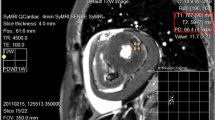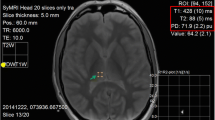Abstract
The goal of the present study was to evaluate if quantitative postmortem cardiac 3-T magnetic resonance (QPMCMR) T1 and T2 relaxation times and proton density values of histopathological early acute and chronic myocardial infarction differ to the quantitative values of non-pathologic myocardium and other histopathological age stages of myocardial infarction with regard to varying corpse temperatures. In 60 forensic corpses (25 female, 35 male), a cardiac 3-T MR quantification sequence was performed prior to autopsy and cardiac dissection. Core body temperature was assessed during MR examinations. Focal myocardial signal alterations in synthetically generated MR images were measured for their T1, T2, and proton density (PD) values. Locations of signal alteration measurements in PMCMR were targeted at heart dissection, and myocardial tissue specimens were taken for histologic examinations. Quantified signal alterations in QPMCMR were correlated to their according histologic age stage of myocardial infarction, and quantitative values were corrected for a temperature of 37 °C. In QPMCMR, 49 myocardial signal alterations were detected in 43 of 60 investigated hearts. Signal alterations were diagnosed histologically as early acute (n = 16), acute (n = 10), acute with hemorrhagic component (n = 9), subacute (n = 3), and chronic (n = 11) myocardial infarction. Statistical analysis revealed that based on their temperature-corrected quantitative T1, T2, and PD values, a significant difference between early acute, acute, and chronic myocardial infarction can be determined. It can be concluded that quantitative 3-T postmortem cardiac MR based on temperature-corrected T1, T2, and PD values may be feasible for pre-autopsy diagnosis of histopathological early acute, acute, and chronic myocardial infarction, which needs to be confirmed histologically.


Similar content being viewed by others
Abbreviations
- ms:
-
Milliseconds
- MRI:
-
Magnetic resonance imaging
- PMI:
-
Postmortem interval
- QPMCMR:
-
Quantitative postmortem cardiac magnetic resonance
- ROC:
-
Receiver operator characteristic
- ROI:
-
Region of interest
- T:
-
Tesla
- T2w:
-
T2-weighted
- TE:
-
Echo time
- TR:
-
Repetition time
- TSE:
-
Turbo spin echo
- PD:
-
Proton density
References
Jackowski C, Schweitzer W, Thali MJ et al (2005) Virtopsy: postmortem imaging of the human heart in situ using MSCT and MRI. Forensic Sci Int 149:11–23
Ruder TD, Ebert LC, Khattab AA, Rieben R, Thali MJ, Kamat P (2013) Edema is a sign of early acute myocardial infarction on post-mortem magnetic resonance imaging. Forensic Sci Med Pathol 9:501–505
Jackowski C, Christe A, Sonnenschein M, Aghayev E, Thali MJ (2006) Postmortem unenhanced magnetic resonance imaging of myocardial infarction in correlation to histological infarction age characterization. Eur Heart J 27:2459–2467
Winklhofer S, Stoeck CT, Berger N et al (2014) Post-mortem cardiac diffusion tensor imaging: detection of myocardial infarction and remodeling of myofiber architecture. Eur Radiol 24(11):2810–2818
Jackowski C, Schwendener N, Grabherr S, Persson A (2013) Postmortem cardiac 3T magnetic resonance imaging: visualizing the sudden cardiac death? J Am Coll Cardiol 62:617–629
Warntjes JB, Dahlqvist O, Lundberg P (2007) Novel method for rapid, simultaneous T1, T*2, and proton density quantification. Magn Reson Med 57:528–537
Warntjes JB, Leinhard OD, West J, Lundberg P (2008) Rapid magnetic resonance quantification on the brain: optimization for clinical usage. Magn Reson Med 60:320–329
Warntjes MJ, Kihlberg J, Engvall J (2010) Rapid T1 quantification based on 3D phase sensitive inversion recovery. BMC Med Imaging 10:19
Warntjes MJ, Engström M, Tisell A, Lundberg P (2015) Modelling the presence of myelin and oedema in the brain based on multi-parametric quantitative MRI. Front Neurol 7:16
Jackowski C, Warntjes MJ, Kihlberg J, Berge J, Thali MJ, Persson A (2011) Quantitative MRI in isotropic spatial resolution for forensic soft tissue documentation. Why and how? J Forensic Sci 56:208–215
Zech WD, Schwendener N, Persson A, Warntjes MJ, Jackowski C (2015) Temperature dependence of postmortem MR quantification for soft tissue discrimination. Eur Radiol 25:2381–2389
Schwendener N, Jackowski C, Persson A, Warntjes MJ, Schuster F, Riva F, Zech WD (2016) Detection and differentiation of early acute and following age stages of myocardial infarction with quantitative post-mortem cardiac 1.5 T MR. Forensic Sci Int. doi:10.1016/j.forsciint.2016.10.014
Zech WD, Schwendener N, Persson A, Warntjes MJ, Jackowski C (2015) Postmortem MR quantification of the heart for characterization and differentiation of ischaemic myocardial lesions. Eur Radiol 25:2067–2073
Zech WD, Hottinger AL, Schwendener N, Schuster F, Persson A, Warntjes MJ, Jackowski C (2016) Post-mortem 1.5 T MR quantification of regular anatomical brain structures. Int J Legal Med 130(4):1071–1080
Shiotani S, Kobayashi T, Hayakawa H, Homma K, Sakahara H (2015) Hepatic relaxation times from postmortem MR imaging of adult humans. Magn Reson Med Sci 15(3):281–287
Tashiro K, Shiotani S, Kobayashi T et al (2015) Cerebral relaxation times from postmortem MR imaging of adults. Magn Reson Med Sci 14(1):51–56
Synthetic MR products website. Available at: http://www.syntheticmr.com. Accessed December 20th, 2016
Schoen F, Mitchell R (2014) The heart. In: Kumar V, Abbas A, Aster J (eds) Robbins and Cotran pathologic basis of disease. Elsevier Saunders, Philadelphia, pp 712–798
Haacke ME, Brown RW, Thompson MR, Venkatesh N (1999) Magnetic resonance imaging-physical principles and sequence design. John Wiley & Sons, New York
Sabatasso S, Mangin P, Fracasso T, Moretti M, Docquier M, Djonov V (2016) Early markers for myocardial ischemia and sudden cardiac death. Int J Legal Med 130(5):1265–1280
Acknowledgements
We would like to thank our teams of forensic pathologists, forensic technicians, histology technicians, and radiologic nurses for their support with case handling. We also thank Mats Fredrikson for his support with statistical analysis.
Author information
Authors and Affiliations
Corresponding author
Rights and permissions
About this article
Cite this article
Persson, A., Baeckmann, J., Berge, J. et al. Temperature-corrected postmortem 3-T MR quantification of histopathological early acute and chronic myocardial infarction: a feasibility study. Int J Legal Med 132, 541–549 (2018). https://doi.org/10.1007/s00414-017-1614-6
Received:
Accepted:
Published:
Issue Date:
DOI: https://doi.org/10.1007/s00414-017-1614-6




